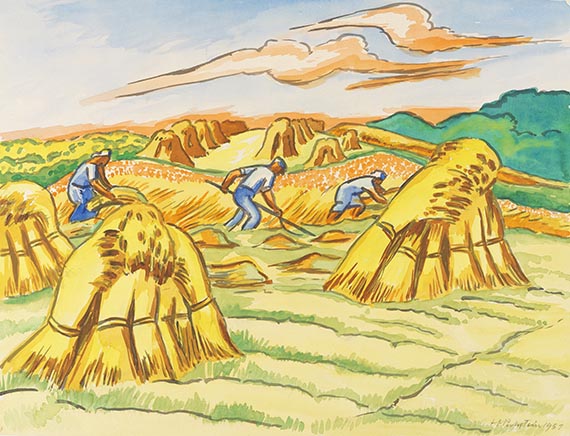
Sandro Botticelli
1445 Florenz
1510 Florenz
Sandro Botticelli, Italian painter and illustrator, whose real name was Alessandro do Mariano Filipepi, was born in Florence in 1445. He is the most important artist of the early Italian Renaissance. After he apprenticed as a goldsmith, he studied painting under the Florentine artist Fra Filippo Lippi (1406-69) from 1465 to 1467. Boticelli’s earliest works of art indicate a close relationship between the styles of pupil and teacher. His most famous early work includes the Adoration of the Magii, now in the Uffizi, painted at the end of the 1470s for the banker Giovanni Lami’s family chapel in the church of Santa Maria Novella. Among the faces are portraits of the Medici family and a self-portrait of the artist.
From this point on Sandro Botticelli became a protégé of the Medici’s, who were among his chief patrons. He received a further commission to do a fresco of the "Adoration" for the Scala della Catena in the Palazzo Vecchio. When the members of the 1478 Pazzi conspiracy were sentenced to death, Botticelli was to paint their portraits on the façade of the Palazzo del Podestà as was then custom.
Sandro Botticelli was hired in 1478 by Lorenzo di Pier Francesco de’Medici (1463-1503) to paint "Primavera" in the Villa di Castello. In 1481, Pope Sixtus IV (1471-84), wishing to have his chapel in the Vatican decorated with frescoes, he invited the best-known Florentine artists of the time to Rome, including Sandro Botticelli, who did three of the frescoes.
Botticelli enjoyed such great admiration among his contemporaries that the pope also entrusted him with the supervision of the Sistine Chapel work.
He returned to Florence in 1482, the same year his pupil Filippino Lippi (1457-1504) painted his portrait. Botticelli was commissioned by Lorenzo de Medici, along with Domenico Ghirlandaio (1449-94) and Filippino Lippi, to decorate a hall and a loggia in the Medici’s Villa Spedaletto near Volterra using secular themes. In 1485, he painted an altarpiece of the seated Madonna for the Bardi Chapel in S. Spirito in Florence. Around the same time, Botticelli carried out a commission to paint the "Birth of Venus" for Lorenzo de Medici, likely intended as a companion piece for "Primavera".
In this work of art, perhaps his most famous, Botticelli did not emphasize perspective and anatomy, considered the two fundamentals of Renaissance art. Today we know the 1487 panorama painted for the hall of the Massai di Camera as the "Madonna della Melagrana (Virgin and Child with Six Angels)". Between 1488 and 1489, Sandro Botticelli painted the "Annunciation of Mary" for the Guardi Chapel in the Church of the Frati di Castello (now called S. Maria Maddalena de Pazzi) for the patron Benedetto Guardi (1436-1491). He completed the large S. Marco altarpiece in Florence in 1490. At the request of patron Lorenzo de Medici, Botticelli was to participate along with Domenico Ghirlandaio and other artists in the mosaic work of the S. Zenobi chapel in the Florence cathedral. But the project remained incomplete due to Lorenzo’s death.
Botticelli was soon hired to illustrate a miniature copy of Dante’s "Divine Comedy" for Lorenzo di Pier Francesco de’Medici, executing around 100 drawings. However, political events in Florence prevented the completion of this project. According to Giorgio Vasari (1511-1574), Botticelli gave up the protection of Lorenzo de’Medici and turned toward the Savonarola party, but this does not appear to be true.
After 1490, Botticelli’s commissions declined significantly, presumably also his reputation. In 1500, he produced his first signed and dated painting, the "Birth of Christ", now in the National Gallery in London. The Vespucci family painting cycle dates from around the same time.
Botticelli’s last works were the history paintings from 1503-04, executed for the Compagnia di San Zenobi in Florence. On January 1504, Botticelli was given the task of deciding where Michelangelo’s "David" would be placed, so he must have still been highly regarded.
Sandro Botticelli died in the middle of May 1510, and was buried in the Ognissanti cemetery in Florence. He was quickly forgotten after his death. Perhaps his style was viewed as old-fashioned and archaic. Not until the nineteenth century was Sandro Botticelli rediscovered by British researchers, and since that time he is considered the best representative of the Florentine Renaissance.

Would you like to sell a work by Sandro Botticelli?
Infos for seller





